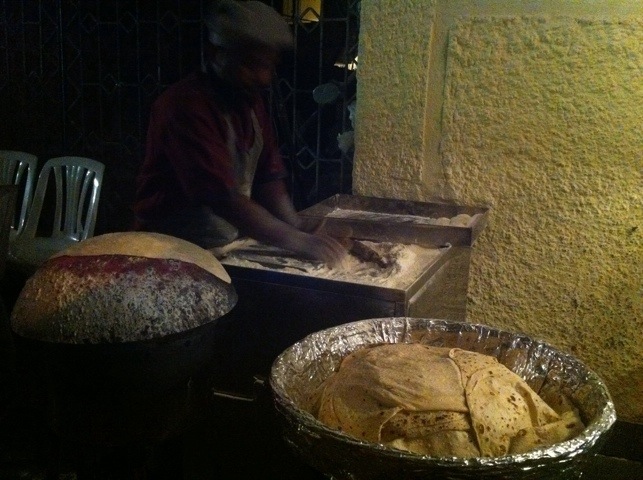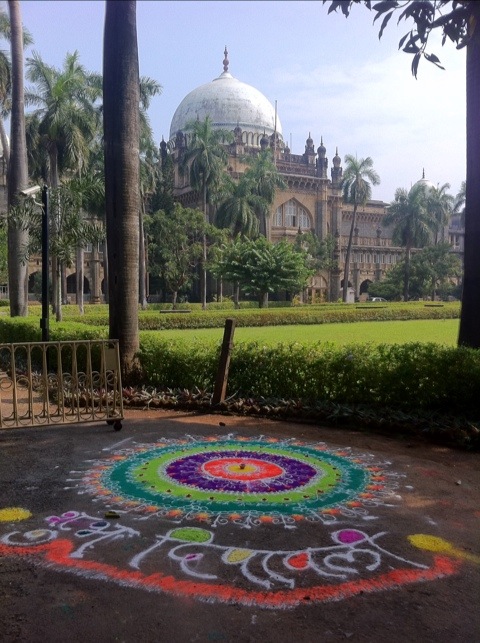As the train rolled through the endless suburbs of Mumbai (formerly Bombay), we saw our first skyscrapers since leaving Beijing 10 weeks ago, and with that a hint of the metropolis we were approaching. As the taxi driver dropped us off an hour later in the costal colonial enclave of Colaba, we were given a couple more pieces of the introduction – a view of the sea, our first costal vista since starting out on our travels; and less pleasingly, an exorbitant taxi bill from the con-man driving us, who had a meter that had clocked up an impressive 41km while our GPS had done just 16. Wearily, we felt the embrace of a welcome to the Big City, India-style!
Mumbai is huge, a sprawling modern mega-city, feeling much bigger (and much more 21st century) than Delhi. As a measure of its size, consider the following picked up from our guidebook. There’s a slum near the airport (as featured in Slumdog Millionaire), home to over a million people, which has its own economy with an estimated annual turnover of £700m from its small businesses. Add to this, the rail network is the busiest on the planet, with three million people carried daily on two lines, at a ‘Super-Dense crush load’ of 14-16 people per square metre (that’s 4700 on a nine carriage train designed for 1700). Sadly we didn’t get to try the trains or visit the enterprising slum of Dharavi – we just had a day between trains and were pretty tired from our trip down from Jaipur. Another one for the ‘next time’ list.
Based on what we’d read, we’d prepared ourselves for Mumbai to be a hectic bustle of mayhem and busy streets, but in the small area of Colaba, we found a lovely mix of old colonial buildings and peaceful avenues, alongside crowds of tourists and streets full of black and yellow taxis.
We went on a fun architectural amble past the Raj-era Gateway to India, the (now renamed) Prince of Wales Museum, and briefly into the High Court (‘just visiting’), an intimidating gothic building with, we’re told, a one-eyed monkey holding the scales of justice on one of the sculptures in a stonemason’s gesture of defiance at authority. Alongside these towering buildings is Oval Maiden, one of three grassy areas in downtown Mumbai that seem to be mainly used for hundreds of
games of the national sport, cricket. We thought we’d seen it in full swing (or is that full toss?) as we were walking around, with about 10 games in progress – but as we drove past in our taxi in the saturday morning departure, it was amazing to see the fields packed with far more people – and all in shimmering cricket whites.

Mumbai’s sombre recent past saw it victim to terror attacks in December 2008, in ‘India’s 9/11’ an event I certainly remember distinctly from the rolling news coverage back home. It was strange to stand outside the Taj Mahal Palace hotel featured prominently in the three day standoff and learn of its much more positive original symbolism – opposing the racism of the Raj, if not quite the class system. The story goes that its wealthy creator, a member of the Tata family, was told that he couldn’t enter one of the rising city’s prestigious beachfront hotels as he was ‘a native’. So he built his own far grander alternative – which has long outlived its colonial rival and remains a potent symbol of Indian nationalism (and thus the reason for it being targeted).
The city is also home to Bollywood, which has churned out nearly 70,000 films since the industry started in the thirties. This conveniently gave us the chance to wear the badge ‘I turned down Bollywood – twice!’, since we were on two occasions invited to be extras in a movie (they prowl the streets of Colaba looking for travellers apparently). Alas, our busy schedules meant we’ll have to wait until our next visit to India for out debut on the silver screen!

In the evening, we popped out to the famous street stall Bade Miya for a tasty set of barbecued lamb and chicken kebabs, wrapped in fantastically thin, huge chapattis. We saw them being cooked in front of us, the bread dropped onto a red-hot hemisphere for a few seconds before being flipped and then served moments later. Delicious!
On that culinary note, one final thing I wanted to mention before we head south: Dabba-wallas, Mumbai’s answer to eating in the office. Each morning, while their loved one is commuting, 200,000 mothers and wives (and for the record, I’d also hope fathers and husbands) make up a tiffin packed lunch for their worker – and deliver it to them using the amazing system of 5000 Dabbi-Wallas, most of whom all originate from the same town. The lunches are picked up from home, marked with a combination of colours and numbers to indicate its destination (deftly avoiding the problem of illiteracy), rushed in on Mumbai’s crazy train system, and delivered just in time. I think the most amazing thing is the accuracy with which this is done, the organisation recently receiving a Forbes 6-sigma performance rating – that means less than 1 lunch in 6 million goes astray. That’s 9 a year in total across the whole city – I think I used to forget my packed lunch more often than that – and that was just for me!
Simon

